CNA340: Enhancing Patient Partnership in Professional Nursing
VerifiedAdded on 2023/06/04
|7
|1383
|352
Report
AI Summary
This nursing assignment critically examines the importance of partnering with patients in healthcare, focusing on the clinician's role in shared decision-making and patient-centered communication. It evaluates the effectiveness of current practices within an organization, highlighting the suboptimal implementation of patient-centered approaches and the need for improvements in fostering healing relationships and information exchange. The report also reflects on the challenges and considerations for future professional practice, emphasizing the importance of communication skills and respecting patient decisions in cancer care. The assignment references relevant literature and national safety and quality health service standards to support its analysis and recommendations. Desklib offers a variety of resources including past papers and solved assignments for nursing students.

Running head: NURSING ASSIGNMENT
NURSING ASSIGNMENT
Name of the Student:
Name of the University:
Author Note:
NURSING ASSIGNMENT
Name of the Student:
Name of the University:
Author Note:
Paraphrase This Document
Need a fresh take? Get an instant paraphrase of this document with our AI Paraphraser
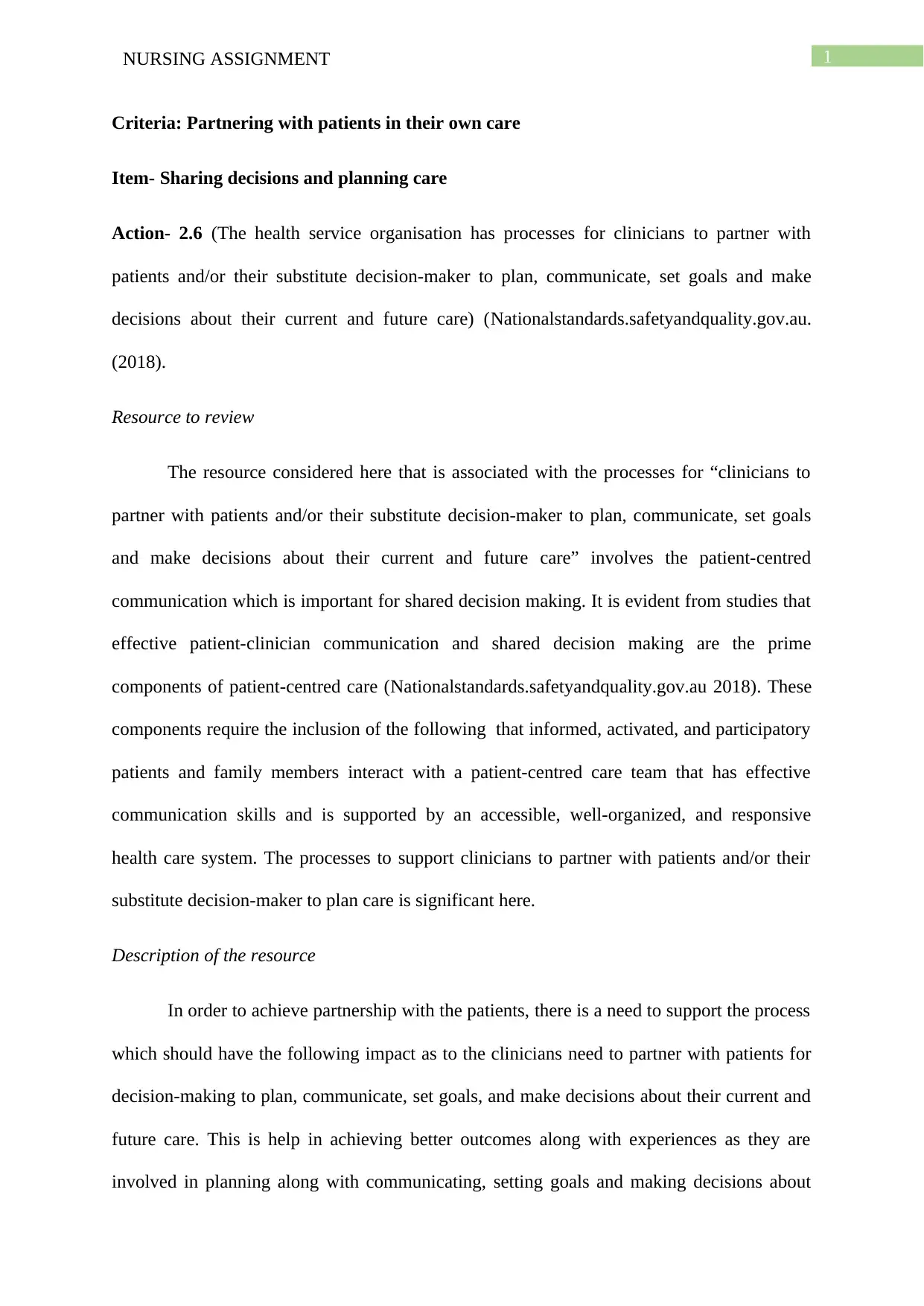
1NURSING ASSIGNMENT
Criteria: Partnering with patients in their own care
Item- Sharing decisions and planning care
Action- 2.6 (The health service organisation has processes for clinicians to partner with
patients and/or their substitute decision-maker to plan, communicate, set goals and make
decisions about their current and future care) (Nationalstandards.safetyandquality.gov.au.
(2018).
Resource to review
The resource considered here that is associated with the processes for “clinicians to
partner with patients and/or their substitute decision-maker to plan, communicate, set goals
and make decisions about their current and future care” involves the patient-centred
communication which is important for shared decision making. It is evident from studies that
effective patient-clinician communication and shared decision making are the prime
components of patient-centred care (Nationalstandards.safetyandquality.gov.au 2018). These
components require the inclusion of the following that informed, activated, and participatory
patients and family members interact with a patient-centred care team that has effective
communication skills and is supported by an accessible, well-organized, and responsive
health care system. The processes to support clinicians to partner with patients and/or their
substitute decision-maker to plan care is significant here.
Description of the resource
In order to achieve partnership with the patients, there is a need to support the process
which should have the following impact as to the clinicians need to partner with patients for
decision-making to plan, communicate, set goals, and make decisions about their current and
future care. This is help in achieving better outcomes along with experiences as they are
involved in planning along with communicating, setting goals and making decisions about
Criteria: Partnering with patients in their own care
Item- Sharing decisions and planning care
Action- 2.6 (The health service organisation has processes for clinicians to partner with
patients and/or their substitute decision-maker to plan, communicate, set goals and make
decisions about their current and future care) (Nationalstandards.safetyandquality.gov.au.
(2018).
Resource to review
The resource considered here that is associated with the processes for “clinicians to
partner with patients and/or their substitute decision-maker to plan, communicate, set goals
and make decisions about their current and future care” involves the patient-centred
communication which is important for shared decision making. It is evident from studies that
effective patient-clinician communication and shared decision making are the prime
components of patient-centred care (Nationalstandards.safetyandquality.gov.au 2018). These
components require the inclusion of the following that informed, activated, and participatory
patients and family members interact with a patient-centred care team that has effective
communication skills and is supported by an accessible, well-organized, and responsive
health care system. The processes to support clinicians to partner with patients and/or their
substitute decision-maker to plan care is significant here.
Description of the resource
In order to achieve partnership with the patients, there is a need to support the process
which should have the following impact as to the clinicians need to partner with patients for
decision-making to plan, communicate, set goals, and make decisions about their current and
future care. This is help in achieving better outcomes along with experiences as they are
involved in planning along with communicating, setting goals and making decisions about
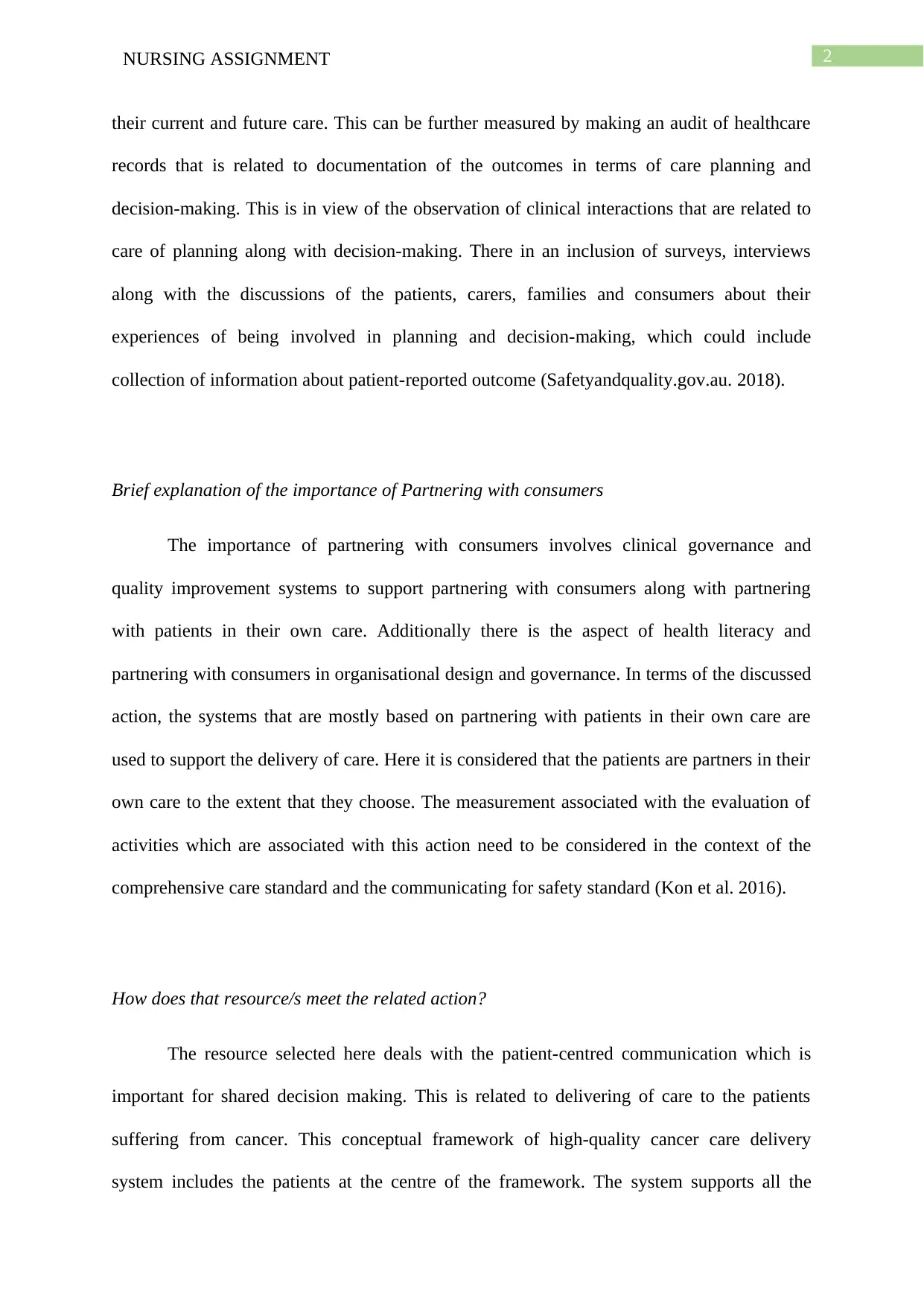
2NURSING ASSIGNMENT
their current and future care. This can be further measured by making an audit of healthcare
records that is related to documentation of the outcomes in terms of care planning and
decision-making. This is in view of the observation of clinical interactions that are related to
care of planning along with decision-making. There in an inclusion of surveys, interviews
along with the discussions of the patients, carers, families and consumers about their
experiences of being involved in planning and decision-making, which could include
collection of information about patient-reported outcome (Safetyandquality.gov.au. 2018).
Brief explanation of the importance of Partnering with consumers
The importance of partnering with consumers involves clinical governance and
quality improvement systems to support partnering with consumers along with partnering
with patients in their own care. Additionally there is the aspect of health literacy and
partnering with consumers in organisational design and governance. In terms of the discussed
action, the systems that are mostly based on partnering with patients in their own care are
used to support the delivery of care. Here it is considered that the patients are partners in their
own care to the extent that they choose. The measurement associated with the evaluation of
activities which are associated with this action need to be considered in the context of the
comprehensive care standard and the communicating for safety standard (Kon et al. 2016).
How does that resource/s meet the related action?
The resource selected here deals with the patient-centred communication which is
important for shared decision making. This is related to delivering of care to the patients
suffering from cancer. This conceptual framework of high-quality cancer care delivery
system includes the patients at the centre of the framework. The system supports all the
their current and future care. This can be further measured by making an audit of healthcare
records that is related to documentation of the outcomes in terms of care planning and
decision-making. This is in view of the observation of clinical interactions that are related to
care of planning along with decision-making. There in an inclusion of surveys, interviews
along with the discussions of the patients, carers, families and consumers about their
experiences of being involved in planning and decision-making, which could include
collection of information about patient-reported outcome (Safetyandquality.gov.au. 2018).
Brief explanation of the importance of Partnering with consumers
The importance of partnering with consumers involves clinical governance and
quality improvement systems to support partnering with consumers along with partnering
with patients in their own care. Additionally there is the aspect of health literacy and
partnering with consumers in organisational design and governance. In terms of the discussed
action, the systems that are mostly based on partnering with patients in their own care are
used to support the delivery of care. Here it is considered that the patients are partners in their
own care to the extent that they choose. The measurement associated with the evaluation of
activities which are associated with this action need to be considered in the context of the
comprehensive care standard and the communicating for safety standard (Kon et al. 2016).
How does that resource/s meet the related action?
The resource selected here deals with the patient-centred communication which is
important for shared decision making. This is related to delivering of care to the patients
suffering from cancer. This conceptual framework of high-quality cancer care delivery
system includes the patients at the centre of the framework. The system supports all the
⊘ This is a preview!⊘
Do you want full access?
Subscribe today to unlock all pages.

Trusted by 1+ million students worldwide
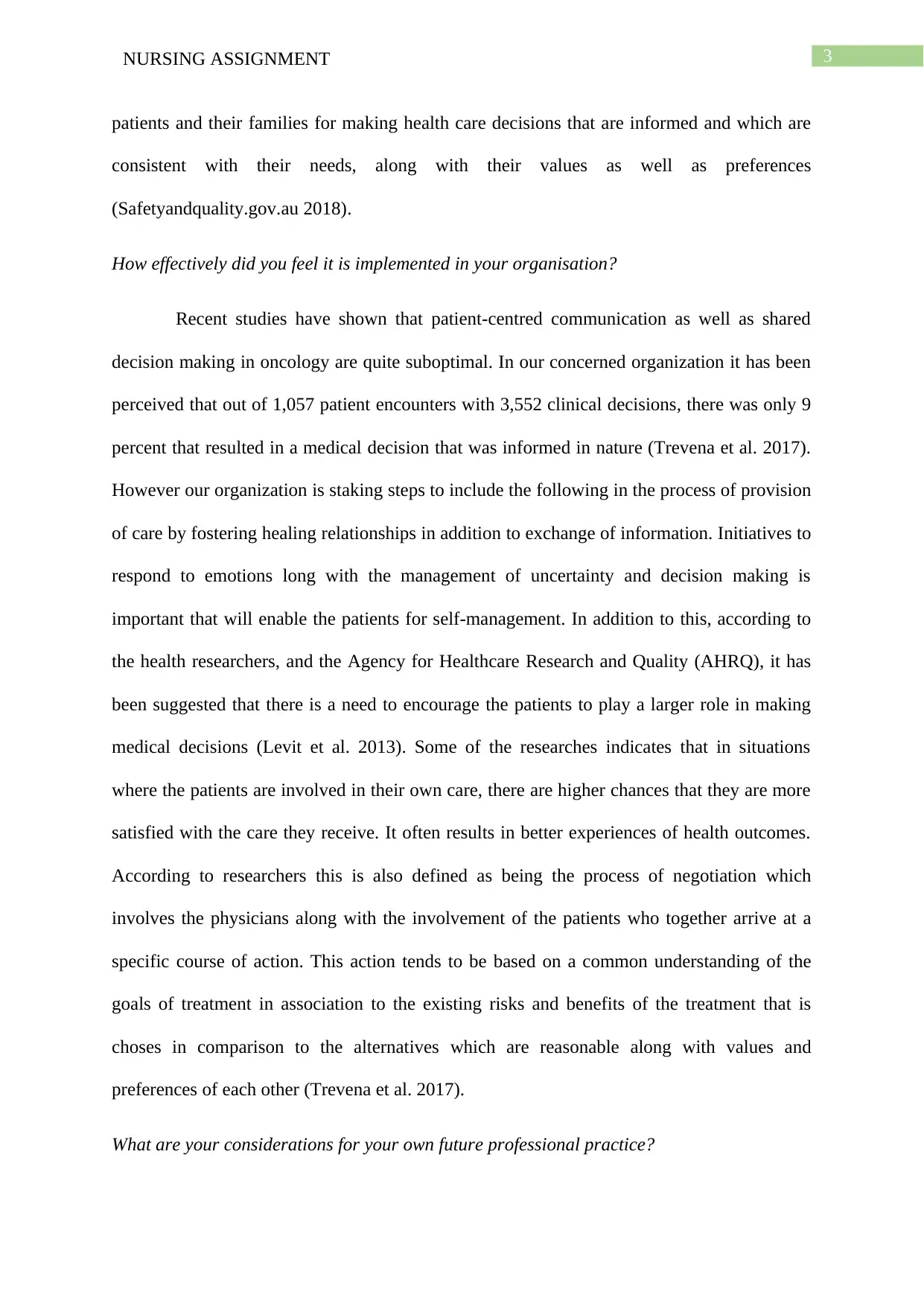
3NURSING ASSIGNMENT
patients and their families for making health care decisions that are informed and which are
consistent with their needs, along with their values as well as preferences
(Safetyandquality.gov.au 2018).
How effectively did you feel it is implemented in your organisation?
Recent studies have shown that patient-centred communication as well as shared
decision making in oncology are quite suboptimal. In our concerned organization it has been
perceived that out of 1,057 patient encounters with 3,552 clinical decisions, there was only 9
percent that resulted in a medical decision that was informed in nature (Trevena et al. 2017).
However our organization is staking steps to include the following in the process of provision
of care by fostering healing relationships in addition to exchange of information. Initiatives to
respond to emotions long with the management of uncertainty and decision making is
important that will enable the patients for self-management. In addition to this, according to
the health researchers, and the Agency for Healthcare Research and Quality (AHRQ), it has
been suggested that there is a need to encourage the patients to play a larger role in making
medical decisions (Levit et al. 2013). Some of the researches indicates that in situations
where the patients are involved in their own care, there are higher chances that they are more
satisfied with the care they receive. It often results in better experiences of health outcomes.
According to researchers this is also defined as being the process of negotiation which
involves the physicians along with the involvement of the patients who together arrive at a
specific course of action. This action tends to be based on a common understanding of the
goals of treatment in association to the existing risks and benefits of the treatment that is
choses in comparison to the alternatives which are reasonable along with values and
preferences of each other (Trevena et al. 2017).
What are your considerations for your own future professional practice?
patients and their families for making health care decisions that are informed and which are
consistent with their needs, along with their values as well as preferences
(Safetyandquality.gov.au 2018).
How effectively did you feel it is implemented in your organisation?
Recent studies have shown that patient-centred communication as well as shared
decision making in oncology are quite suboptimal. In our concerned organization it has been
perceived that out of 1,057 patient encounters with 3,552 clinical decisions, there was only 9
percent that resulted in a medical decision that was informed in nature (Trevena et al. 2017).
However our organization is staking steps to include the following in the process of provision
of care by fostering healing relationships in addition to exchange of information. Initiatives to
respond to emotions long with the management of uncertainty and decision making is
important that will enable the patients for self-management. In addition to this, according to
the health researchers, and the Agency for Healthcare Research and Quality (AHRQ), it has
been suggested that there is a need to encourage the patients to play a larger role in making
medical decisions (Levit et al. 2013). Some of the researches indicates that in situations
where the patients are involved in their own care, there are higher chances that they are more
satisfied with the care they receive. It often results in better experiences of health outcomes.
According to researchers this is also defined as being the process of negotiation which
involves the physicians along with the involvement of the patients who together arrive at a
specific course of action. This action tends to be based on a common understanding of the
goals of treatment in association to the existing risks and benefits of the treatment that is
choses in comparison to the alternatives which are reasonable along with values and
preferences of each other (Trevena et al. 2017).
What are your considerations for your own future professional practice?
Paraphrase This Document
Need a fresh take? Get an instant paraphrase of this document with our AI Paraphraser
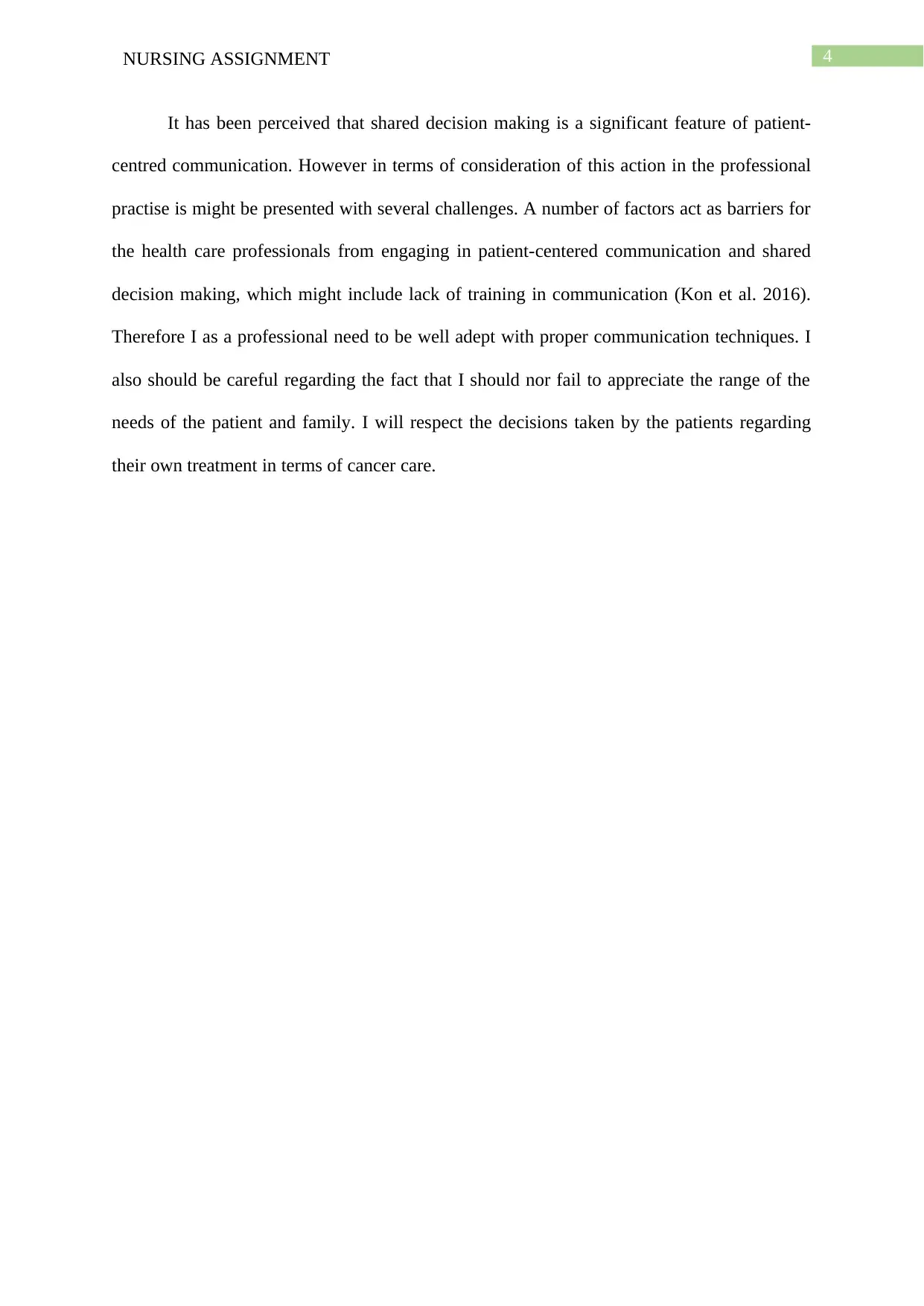
4NURSING ASSIGNMENT
It has been perceived that shared decision making is a significant feature of patient-
centred communication. However in terms of consideration of this action in the professional
practise is might be presented with several challenges. A number of factors act as barriers for
the health care professionals from engaging in patient-centered communication and shared
decision making, which might include lack of training in communication (Kon et al. 2016).
Therefore I as a professional need to be well adept with proper communication techniques. I
also should be careful regarding the fact that I should nor fail to appreciate the range of the
needs of the patient and family. I will respect the decisions taken by the patients regarding
their own treatment in terms of cancer care.
It has been perceived that shared decision making is a significant feature of patient-
centred communication. However in terms of consideration of this action in the professional
practise is might be presented with several challenges. A number of factors act as barriers for
the health care professionals from engaging in patient-centered communication and shared
decision making, which might include lack of training in communication (Kon et al. 2016).
Therefore I as a professional need to be well adept with proper communication techniques. I
also should be careful regarding the fact that I should nor fail to appreciate the range of the
needs of the patient and family. I will respect the decisions taken by the patients regarding
their own treatment in terms of cancer care.
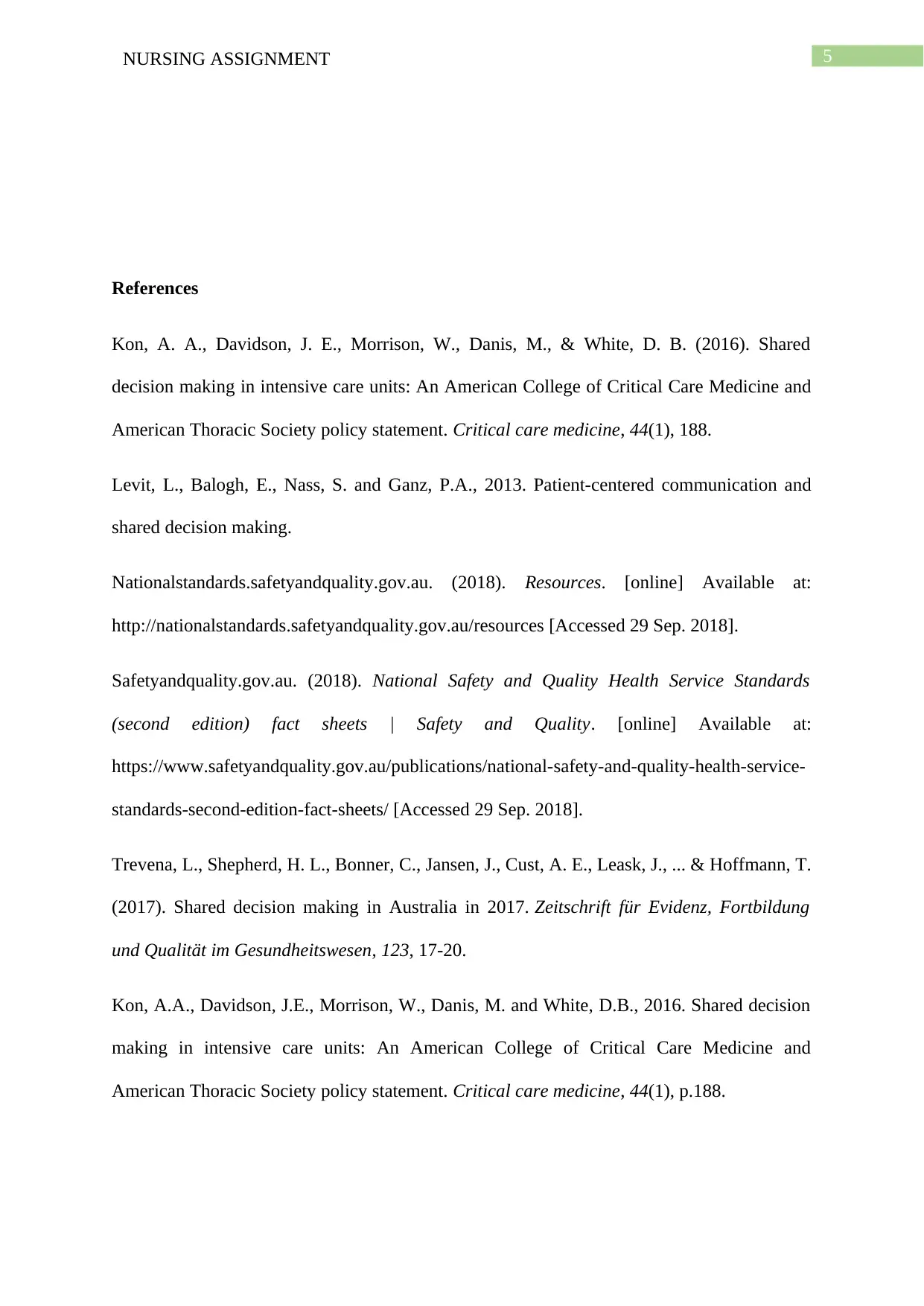
5NURSING ASSIGNMENT
References
Kon, A. A., Davidson, J. E., Morrison, W., Danis, M., & White, D. B. (2016). Shared
decision making in intensive care units: An American College of Critical Care Medicine and
American Thoracic Society policy statement. Critical care medicine, 44(1), 188.
Levit, L., Balogh, E., Nass, S. and Ganz, P.A., 2013. Patient-centered communication and
shared decision making.
Nationalstandards.safetyandquality.gov.au. (2018). Resources. [online] Available at:
http://nationalstandards.safetyandquality.gov.au/resources [Accessed 29 Sep. 2018].
Safetyandquality.gov.au. (2018). National Safety and Quality Health Service Standards
(second edition) fact sheets | Safety and Quality. [online] Available at:
https://www.safetyandquality.gov.au/publications/national-safety-and-quality-health-service-
standards-second-edition-fact-sheets/ [Accessed 29 Sep. 2018].
Trevena, L., Shepherd, H. L., Bonner, C., Jansen, J., Cust, A. E., Leask, J., ... & Hoffmann, T.
(2017). Shared decision making in Australia in 2017. Zeitschrift für Evidenz, Fortbildung
und Qualität im Gesundheitswesen, 123, 17-20.
Kon, A.A., Davidson, J.E., Morrison, W., Danis, M. and White, D.B., 2016. Shared decision
making in intensive care units: An American College of Critical Care Medicine and
American Thoracic Society policy statement. Critical care medicine, 44(1), p.188.
References
Kon, A. A., Davidson, J. E., Morrison, W., Danis, M., & White, D. B. (2016). Shared
decision making in intensive care units: An American College of Critical Care Medicine and
American Thoracic Society policy statement. Critical care medicine, 44(1), 188.
Levit, L., Balogh, E., Nass, S. and Ganz, P.A., 2013. Patient-centered communication and
shared decision making.
Nationalstandards.safetyandquality.gov.au. (2018). Resources. [online] Available at:
http://nationalstandards.safetyandquality.gov.au/resources [Accessed 29 Sep. 2018].
Safetyandquality.gov.au. (2018). National Safety and Quality Health Service Standards
(second edition) fact sheets | Safety and Quality. [online] Available at:
https://www.safetyandquality.gov.au/publications/national-safety-and-quality-health-service-
standards-second-edition-fact-sheets/ [Accessed 29 Sep. 2018].
Trevena, L., Shepherd, H. L., Bonner, C., Jansen, J., Cust, A. E., Leask, J., ... & Hoffmann, T.
(2017). Shared decision making in Australia in 2017. Zeitschrift für Evidenz, Fortbildung
und Qualität im Gesundheitswesen, 123, 17-20.
Kon, A.A., Davidson, J.E., Morrison, W., Danis, M. and White, D.B., 2016. Shared decision
making in intensive care units: An American College of Critical Care Medicine and
American Thoracic Society policy statement. Critical care medicine, 44(1), p.188.
⊘ This is a preview!⊘
Do you want full access?
Subscribe today to unlock all pages.

Trusted by 1+ million students worldwide

6NURSING ASSIGNMENT
1 out of 7
Related Documents
Your All-in-One AI-Powered Toolkit for Academic Success.
+13062052269
info@desklib.com
Available 24*7 on WhatsApp / Email
![[object Object]](/_next/static/media/star-bottom.7253800d.svg)
Unlock your academic potential
Copyright © 2020–2025 A2Z Services. All Rights Reserved. Developed and managed by ZUCOL.





